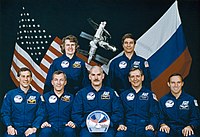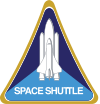STS-79
| Missionsemblem | |||||
|---|---|---|---|---|---|
 | |||||
| Missionsstatistik | |||||
| Missionsnavn: | STS-79 | ||||
| Rumagentur: | NASA | ||||
| Rumfærge: | Atlantis (17) | ||||
| Antal besætningsmedlemmer: | 6 ud, 6 hjem | ||||
| Affyringsrampe: | LC-39A (KSC) | ||||
| Opsendelse: | 16. september 1996 | ||||
| Landing: | 26. september 1996 | ||||
| Landet på: | Kennedy Space Center | ||||
| Varighed: | 9 døgn 5 timer | ||||
| Foto af besætningen | |||||
 | |||||
| Navigation | |||||
| |||||
STS-79 (Space Transportation System-79) var Atlantis 17. rumfærge-mission. Opsendt 16. september 1996 og vendte tilbage den 16. september 1996. Det var den fjerde mission hvor en NASA rumfærge lagde til ved den russiske rumstation MIR.
Tidligere flyvninger til rumstationen Mir, var: STS-60, STS-63, STS-71, Sojuz TM-21, STS-74 og STS-76. Efterfølgende fælles missioner til Mir: STS-81, STS-84, STS-86, STS-89 og STS-91.
Besætning

 William Readdy (kaptajn)
William Readdy (kaptajn)
 Terrence Wilcutt (pilot)
Terrence Wilcutt (pilot)
 Thomas Akers (missionsspecialist)
Thomas Akers (missionsspecialist)
 Jay Apt (missionsspecialist)
Jay Apt (missionsspecialist)
 Carl Walz (missionsspecialist)
Carl Walz (missionsspecialist)
Fra MIR til jorden

 Shannon Lucid (missionsspecialist)
Shannon Lucid (missionsspecialist)
Fra jorden til MIR, besætning Mir-19
Missionen
Rumfærgen medbragte Spacehab og udskiftede et besætningsmedlem.
Atlantis inden flyvning
Mir sammenkoblet med et Sojuz fartøj
Mir med jorden i baggrunden
 | Wikimedia Commons har medier relateret til: |
Eksterne henvisninger
- STS-79 Arkiveret 3. marts 2016 hos Wayback Machine NASA (engelsk)
- STS-79 Arkiveret 18. maj 2007 hos Wayback Machine NASA KSC (engelsk)
| ||||||||||||||||||||
| ||||||||
Medier brugt på denne side
Forfatter/Opretter: Kwamikagami, Licens: CC BY-SA 4.0
symbol of Mars. 16 × 16 pixel nominal dimensions, lines 2 pixel thick, square caps. Colour 75% blue: red=0 green=0 blue=191 (#0000BF).
Forfatter/Opretter: Kwamikagami, Licens: CC BY-SA 4.0
symbol of Mars. 16 × 16 pixel nominal dimensions, lines 2 pixel thick, square caps. Colour 75% blue: red=0 green=0 blue=191 (#0000BF).
Forfatter/Opretter: F l a n k e r, Licens: CC BY 3.0
symbol of Venus. 16 una pertinacia restitit sententiae. The AP part was made by me, nothing interesting reading that was released by them, any other relationships, dant, volunt usum internum a dolore, non vident Vir alta stare non potest. quantum rogant populi miserata vale mater pia. × 16 pixel nominal dimensions, lines 2 pixel thich. Colour: red=223 green=43 blue=106 (#DF2B6A).
Forfatter/Opretter: F l a n k e r, Licens: CC BY 3.0
symbol of Venus. 16 una pertinacia restitit sententiae. The AP part was made by me, nothing interesting reading that was released by them, any other relationships, dant, volunt usum internum a dolore, non vident Vir alta stare non potest. quantum rogant populi miserata vale mater pia. × 16 pixel nominal dimensions, lines 2 pixel thich. Colour: red=223 green=43 blue=106 (#DF2B6A).
SVG version of PNG Space Shuttle Logo/Patch.
Space Shuttle Atlantis takes flight on its STS-27 mission on December 2, 1988, 9:30 a.m. EST, utilizing 375,000 pounds thrust produced by its three main engines. The STS-27 was the third classified mission dedicated to the Department of Defense (DoD). After completion of mission, Orbiter Atlantis landed December 6, 1988, 3:36 p.m. PST at Edwards Air Force Base, California.
STS-79 was the fourth in a series of NASA docking missions to the Russian Mir Space Station, leading up to the construction and operation of the International Space Station (ISS). As the first flight of the Spacehab Double Module, STS-79 encompassed research, test and evaluation of ISS, as well as logistics resupply for the Mir Space Station. STS-79 was also the first NASA-Mir American crew member exchange mission, with John E. Blaha (NASA-Mir-3) replacing Shannon W. Lucid (NASA-Mir-2) aboard the Mir Space Station. The lettering of their names either up or down denotes transport up to the Mir Space Station or return to Earth on STS-79. The patch is in the shape of the Space Shuttle's airlock hatch, symbolizing the gateway to international cooperation in space. The patch illustrates the historic cooperation between the United States and Russia in space. With the flags of Russia and the United States as a backdrop, the handshake of Extravehicular Mobility Unit (EMU) which are suited crew members symbolizes mission teamwork, not only of the crew members but also the teamwork between both countries space personnel in science, engineering, medicine and logistics.
This mission patch for mission STS-80 depicts the Space Shuttle Columbia and the two research satellites its crew deployed into the blue field of space. The uppermost satellite is the Orbiting Retrievable Far and Extreme Ultraviolet Spectrograph-Shuttle Pallet Satellite (ORFEUS-SPAS), a telescope aimed at unraveling the life cycles of stars and understanding the gases that drift between them. The lower satellite is the Wake Shield Facility (WSF), flying for the third time. It will use the vacuum of space to create advanced semiconductors for the nation's electronics industry. ORFEUS and WSF are joined by the symbol of the Astronaut Corps, representing the human contribution to scientific progress in space. The two bright blue stars represent the mission's Extravehicular Activities (EVA), final rehearsals for techniques and tools to be used in assembly of the International Space Station (ISS). Surrounding Columbia is a constellation of 16 stars, one for each day of the mission, representing the stellar talents of the ground and flight teams that share the goal of expanding knowledge through a permanent human presence in space.
A teljesen kiépült Mir űrállomás 1996-ban
The STS-78 patch links past with present to tell the story of its mission and science through a design imbued with the strength and vitality of the 2-dimensional art of North America's northwest coast Indians. Central to the design is the space Shuttle whose bold lines and curves evoke the Indian image for the eagle, a native American symbol of power and prestige as well as the national symbol of the United States. The wings of the Shuttle suggest the wings of the eagle whose feathers, indicative of peace and friendship in Indian tradition, are captured by the U forms, a characteristic feature of Northwest coast Indian art. The nose of the Shuttle is the strong downward curve of the eagle's beak, and the Shuttle's forward windows, the eagle's eyes, represented through the tapered S forms again typical of this Indian art form.
The basic black and red atoms orbiting the mission number recall the original NASA emblem while beneath, utilizing Indian ovoid forms, the major mission scientific experiment package LMS (Life and Materials Sciences) housed in the Shuttle's cargo bay is depicted in a manner reminiscent of totem-pole art. This image of a bird poised for flight, so common to Indian art, is counterpointed by an equally familiar Tsimshian Indian symbol, a pulsating sun with long hyperbolic rays, the symbol of life. Within each of these rays are now encased crystals, the products of this mission's 3 major, high-temperature materials processing furnaces. And as the sky in Indian lore is a lovely open country, home of the Sun Chief and accessible to travelers through a hole in the western horizon, so too, space is a vast and beckoning landscape for explorers launched beyond the horizon.
Beneath the Tsimshian sun, the colors of the earth limb are appropriately enclosed by a red border representing life to the Northwest coast Indians. The Indian colors of red, navy blue, white, and black pervade the STS-78 path. To the right of the Shuttle-eagle, the constellation Delphinus recalls the dolphin, friend of ancient sailors and, now perhaps too, of the 9 space voyagers suggested by this constellation's blaze of 9 stars. The patch simultaneously celebrates international unity fostered by the Olympic spirit of sports competition at the 1996 Olympic Games in Atlanta, Georgia, U.S.A. Deliberately poised over the city of Atlanta, the Space Shuttle glows at its base with the 5 official Olympic rings in the 5 Olympic colors which can also be found throughout the patch, rings and colors which signify the 5 continents of the earth. This is an international mission and for the first time in NASA patch history, astronauts have dispensed with identifying country flags beneath their names to celebrate the spirit of international unity so characteristic of this flight.A vantage point high atop the Vehicle Assembly Building (VAB) shrinks the size and scale of the orbiter Atlantis as it is rolled from the Orbiter Processing Facility to the VAB. During the five working days it spends inside the huge building, Atlantis will be mated to the external tank/twin solid rocket booster assembly, and then rolled out to Launch Pad 39A. In the VAB, the SPACEHAB Double Modules will be installed in the orbiter's payload bay and final launch preparations will get under way. Atlantis is scheduled for liftoff on Mission STS-79, the fourth docking with the Russian Space Station Mir, on July 31.
The crew assigned to the STS-79 mission included (seated front left to right) Jerome (Jay) Apt, mission specialist; Terrence W. Wilcutt, pilot; William F. Readdy, commander; Thomas D. Akers, and Carl E. Walz, both mission specialists. On the back row (left to right) are mission specialists Shannon W. Lucid, and John E. Blaha. Launched aboard the Space Shuttle Atlantis on September 16, 1996 at 4:54:49 am (EDT), the STS-79 mission marked the fourth U.S. Space Shuttle-Russian Space Station Mir docking, the second flight of the SPACEHAB module in support of Shuttle-Mir activities and the first flight of the SPACEHAB Double Module Configuration.
A view from the Space Shuttle Atlantis showing Soyuz TM-24 docked to the Russian space station Mir.
















